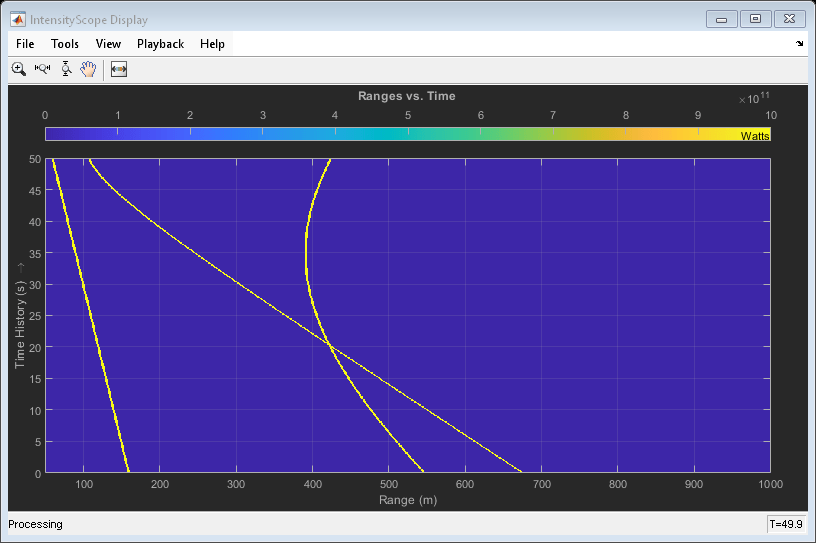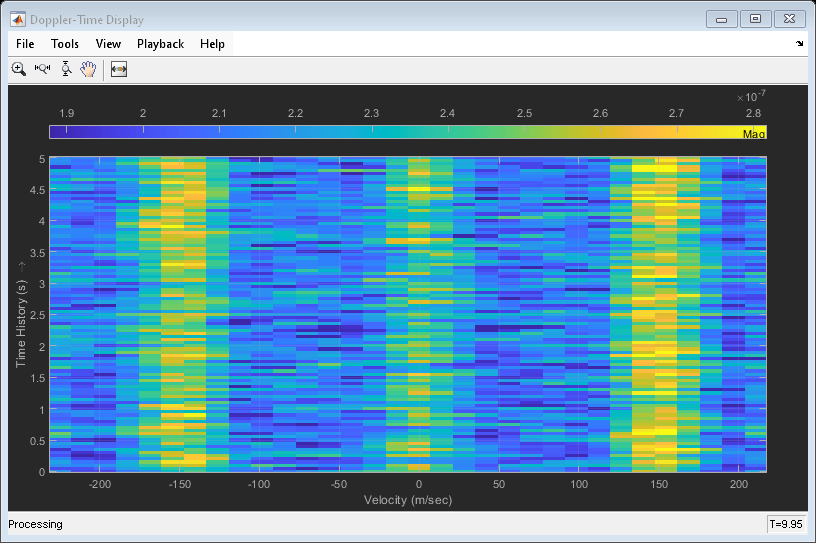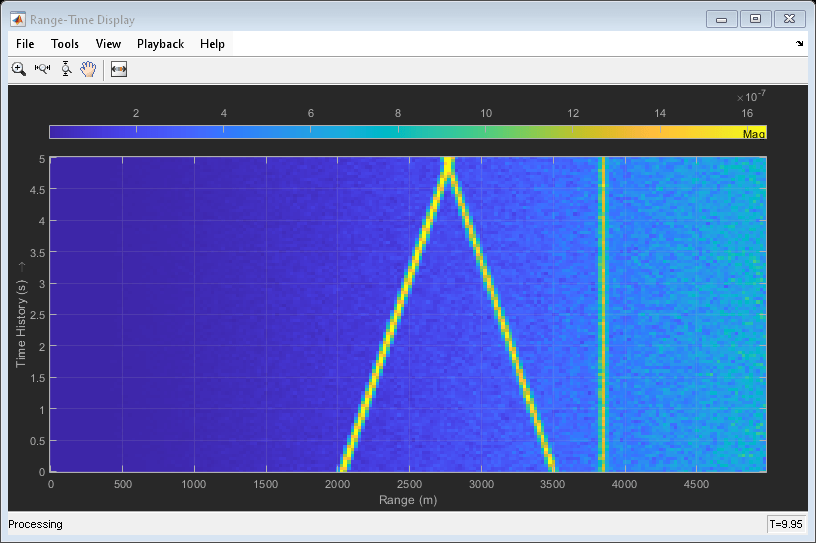phased.IntensityScope
Range-time-intensity (RTI) or Doppler-time-intensity (DTI) display
Description
The phased.IntensityScope
System object™ creates an intensity scope for viewing range-time-intensity (RTI) or
Doppler-time-intensity (DTI) data. An intensity scope is a scrolling waterfall of intensity
values as a function of time. Scan lines appear at the bottom of the display window and scroll
off at the top. Each scan line represents signal intensity as a function of a parameter of
interest, such as range or speed. You can also use this object to display angle-time-intensity
data and spectral data. This figure shows an RTI display.

To create an intensity scope:
Define and set up the
phased.IntensityScopeSystem object. You can set any System object properties at this time or you can leave them at their default values. See Construction.Call the
stepmethod to add intensity lines to the bottom of the display according to the properties of thephased.IntensityScopeSystem object. Some properties are tunable and can be changed at any time. Non-tunable properties cannot be changed after the first call tostep. Subsequent calls tostepadd more intensity lines.
Note
Starting in R2016b, instead of using the step method to
perform the operation defined by the System object, you can call the object with arguments, as if it were a function. For example,
y = step(obj,x) and y = obj(x) perform equivalent
operations.
Construction
sIS = phased.IntensityScopesIS, having default property values.
sIS = phased.IntensityScope(Name,Value)sIS, with each specified property Name set
to a specified Value. Name must appear inside single quotes
(''). You can specify several name-value pair arguments in any order as
Name1,Value1,...,NameN,ValueN.
Properties
Intensity scope window name, specified as a character vector. Name
property and Title are different properties. The title appears inside the
display window, above the data. The name appears in the title bar of the window.
Example: 'Range Intensity'
Data Types: char
X-axis sample spacing, specified as a positive real-valued scalar. This quantity
determines the width of each horizontal bin of the scan line. The units depend on the
interpretation of the data. For example, if you are creating an RTI display, then setting
XResolution to 0.5 is interpreted as 0.5
meters.
Example: 0.5
Data Types: double
X-axis offset, specified as a real-valued scalar. This quantity sets the value of the
lowest bin of the scan line. The values of all other bins are equal to this value plus an
integer multiple of Xresolution. The units depend upon the interpretation
of the data. For example, if you are creating an RTI display, then setting
XOffset to 100.0 is interpreted as 100 meters.
Example: -0.1
Data Types: double
X-axis label, specified as a character vector.
Example: 'Range (km)'
Data Types: char
Title of the intensity scope display, specified as a character vector.
Title property and Name are different properties.
The title appears inside the display window, above the data. The name appears in the title bar
of the window.
Example: 'Range vs Time'
Data Types: char
Time resolution of intensity line(s), specified as a positive real-valued scalar. Units are seconds.
Example: .0001
Data Types: double
Time span of intensity display, specified as a positive real-valued scalar. Units are seconds.
Example: 5.0
Data Types: double
Intensity units label displayed in the color bar, specified as a character vector.
Example: 'Watts'
Data Types: char
Location and size of the intensity scope window, specified as a 1-by-4 vector having the
form [left bottom width height]. Units are in pixels.
leftandbottomspecify the location of the bottom-left corner of the window.widthandheightspecify the width and height of the window.
The default value of this property depends on the resolution of your display. This property is tunable.
Example: [100 100 500 400]
Data Types: double
Methods
| hide | Hide intensity scope window |
| reset | Reset state of intensity scope System object |
| show | Show intensity scope window |
| step | Update intensity scope display |
| Common to All System Objects | |
|---|---|
release | Allow System object property value changes |
Examples
Use a phased.IntensityScope System object™ to display the echo intensity of a moving target as a function of range and time.
Run the simulation for 5 seconds at 0.1 second steps. In the display, each horizontal scan line shows the intensities of radar echo at each time step.
nsteps = 50; dt = .1; timespan = nsteps*dt;
Simulate a target at a range of 320.0 km and a range rate of 2.0 km/s. Echoes are resolved into range bins of 1 km resolution. The range bins span from 50 to 1000 km.
rngres = 1.0; rngmin = 50.0; rngmax = 1000.0; tgtrange = 320.0; rangerate = 2.0; rngscan = [rngmin:rngres:rngmax];
Set up the Intensity Scope using these properties.
Use the
XResolutionproperty to set the width of each scan line bin to the range resolution of 1 km.Use the
XOffsetproperty to set the value of the lowest range bin to the minimum range of 50 km.Use the
TimeResolutionproperty to set the value of the scan line time difference to 0.1 s.Use the
TimeSpanproperty to set the height of the display window to the time duration of the simulation.Use the
IntensityUnitsproperty to set the display units toWatts.
scope = phased.IntensityScope('Name','IntensityScope Display',... 'Title','Range vs. Time','XLabel','Range (km)',... 'XResolution',rngres,'XOffset',rngmin,... 'TimeResolution',dt,'TimeSpan',timespan, ... 'IntensityUnits','Watts','Position',[100,100,800,450]);
Update the current target bin and create entries for two adjacent range bins. Each call to the step method creates a new scan line.
for k = 1:nsteps bin = floor((tgtrange - rngmin)/rngres) + 1; scanline = zeros(size(rngscan)); scanline(bin+[-1:1]) = 1; scope(scanline.'); tgtrange = tgtrange + dt*rangerate; pause(.1); end

Use the phased.IntensityScope System object™ to display the intensities of the echoes of three moving targets as functions of range and time.
Create the Radar and Target System Objects
Set up the initial positions and velocities of the three targets. Use the phased.Platform System object to model radar and target motions. The radar is stationary while the targets undergo constant velocity motion. The simulation runs for 500 steps at 0.1 second increments, giving a total simulation time of 50 seconds.
nsteps = 500; dt = .1; timespan = nsteps*dt; x1 = [60,0,0]'; x2 = [60,-80,40]'; x3 = [300,0,-300]'; v1 = [2,0,0]'; v2 = [10,5,6]'; v3 = [-10,2,-4]'; platform = phased.Platform([0,0,0]',[0,0,0]'); targets = phased.Platform([x1,x2,x3],[v1,v2,v3]);
Set Up Range Bins
Each echo is put into a range bin. The range bin resolution is 1 meter and the range is from 50 to 1000 meters.
rngres = 1.0; rngmin = 50.0; rngmax = 1000.0; rngscan = [rngmin:rngres:rngmax];
Create the Gain Function
Define a range-dependent gain function to enhance the display of targets at larger ranges. The gain function amplifies the returned echo for visualization purposes only.
rangegain = @(rng)(1e12*rng^4);
Create the Intensity Scope
Set up the Intensity Scope using these properties.
Use the
XResolutionproperty to set the width of each scan line bin to the range resolution of 1 km.Use the
XOffsetproperty to set the value of the lowest range bin to the minimum range of 50 km.Use the
TimeResolutionproperty to set the value of the scan line time difference to 0.1 s.Use the
TimeSpanproperty to set the height of the display window to the time duration of the simulation.Use the
IntensityUnitsproperty to set the display units toWatts.
scope = phased.IntensityScope('Name','IntensityScope Display',... 'Title','Ranges vs. Time','XLabel','Range (m)','XResolution',rngres,... 'XOffset',rngmin,'TimeResolution',dt,'TimeSpan',timespan, ... 'IntensityUnits','Watts','Position',[100,100,800,450]);
Run Simulation Loop
In this loop, move the targets at constant velocity using the
stepmethod of thephased.PlatformSystem object.Compute the target ranges using the
rangeanglefunction.Compute the target range bins by quantizing the range values in integer multiples of
rngres.Fill each target range bin and neighboring bins with a simulated radar intensity value.
Add the signal from each target to the scan line.
Call the
stepmethod of thephased.IntensityScopeSystem object to display the scan lines.
for k = 1:nsteps xradar = platform(dt); xtgts = targets(dt); [rngs] = rangeangle(xtgts,xradar); scanline = zeros(size(rngscan)); rngindx = ceil((rngs(1) - rngmin)/rngres); scanline(rngindx + [-1:1]) = rangegain(rngs(1))/(rngs(1)^4); rngindx = ceil((rngs(2) - rngmin)/rngres); scanline(rngindx + [-1:1]) = rangegain(rngs(2))/(rngs(2)^4); rngindx = ceil((rngs(3) - rngmin)/rngres); scanline(rngindx + [-1:1]) = rangegain(rngs(3))/(rngs(3)^4); scope(scanline.'); pause(.1); end

Use the phased.IntensityScope System Object™ to display the detection output of a radar system simulation. The radar scenario contains a stationary single-element monostatic radar and three moving targets.
Set Radar Operating Parameters
Set the maximum range, peak power range resolution, operating frequency, transmitter gain, and target radar cross-section.
max_range = 5000; range_res = 50; fc = 10e9; tx_gain = 20; peak_power = 5500.0;
Choose the signal propagation speed to be the speed of light, and compute the signal wavelength corresponding to the operating frequency.
c = physconst('LightSpeed');
lambda = c/fc;
Compute the pulse bandwidth from the range resolution. Set the sampling rate, fs, to twice the pulse bandwidth. The noise bandwidth is also set to the pulse bandwidth. The radar integrates a number of pulses set by num_pulse_int. The duration of each pulse is the inverse of the pulse bandwidth.
pulse_bw = c/(2*range_res); pulse_length = 1/pulse_bw; fs = 2*pulse_bw; noise_bw = pulse_bw; num_pulse_int = 10;
Set the pulse repetition frequency to match the maximum range of the radar.
prf = c/(2*max_range);
Create System Objects for the Model
Choose a rectangular waveform.
waveform = phased.RectangularWaveform('PulseWidth',pulse_length,... 'PRF',prf,'SampleRate',fs);
Set the receiver amplifier characteristics.
amplifier = phased.ReceiverPreamp('Gain',20,'NoiseFigure',0,... 'SampleRate',fs,'EnableInputPort',true,'SeedSource','Property',... 'Seed',2007); transmitter = phased.Transmitter('Gain',tx_gain,'PeakPower',peak_power,... 'InUseOutputPort',true);
Specify the radar antenna as a single isotropic antenna.
antenna = phased.IsotropicAntennaElement('FrequencyRange',[5e9 15e9]);
Set up a monostatic radar platform.
radarplatform = phased.Platform('InitialPosition',[0; 0; 0],... 'Velocity',[0; 0; 0]);
Set up the three target platforms using a single System object.
targetplatforms = phased.Platform(... 'InitialPosition',[2000.66 3532.63 3845.04; 0 0 0; 0 0 0], ... 'Velocity',[150 -150 0; 0 0 0; 0 0 0]);
Create the radiator and collector System objects.
radiator = phased.Radiator('Sensor',antenna,'OperatingFrequency',fc); collector = phased.Collector('Sensor',antenna,'OperatingFrequency',fc);
Set up the three target RCS properties.
targets = phased.RadarTarget('MeanRCS',[1.6 2.2 1.05],'OperatingFrequency',fc);
Create System object to model two-way freespace propagation.
channels= phased.FreeSpace('SampleRate',fs,'TwoWayPropagation',true,... 'OperatingFrequency',fc);
Define a matched filter.
MFcoef = getMatchedFilter(waveform); mfilter = phased.MatchedFilter('Coefficients',MFcoef,'GainOutputPort',true);
Create Range and Doppler Bins
Set up the fast-time grid. Fast time is the sampling time of the echoed pulse relative to the pulse transmission time. The range bins are the ranges corresponding to each bin of the fast time grid.
fast_time = unigrid(0,1/fs,1/prf,'[)');
range_bins = c*fast_time/2;
To compensate for range loss, create a time varying gain System Object.
gain = phased.TimeVaryingGain('RangeLoss',2*fspl(range_bins,lambda),... 'ReferenceLoss',2*fspl(max_range,lambda));
Set up Doppler bins. Doppler bins are determined by the pulse repetition frequency. Create an FFT System object for Doppler processing.
DopplerFFTbins = 32; DopplerRes = prf/DopplerFFTbins; fft = dsp.FFT('FFTLengthSource','Property',... 'FFTLength',DopplerFFTbins);
Create Data Cube
Set up a reduced data cube. Normally, a data cube has fast-time and slow-time dimensions and the number of sensors. Because the data cube has only one sensor, it is two-dimensional.
rx_pulses = zeros(numel(fast_time),num_pulse_int);
Create IntensityScope System Objects
Create two IntensityScope System objects, one for Doppler-time-intensity and the other for range-time-intensity.
dtiscope = phased.IntensityScope('Name','Doppler-Time Display',... 'XLabel','Velocity (m/sec)', ... 'XResolution',dop2speed(DopplerRes,c/fc)/2, ... 'XOffset',dop2speed(-prf/2,c/fc)/2,... 'TimeResolution',0.05,'TimeSpan',5,'IntensityUnits','Mag'); rtiscope = phased.IntensityScope('Name','Range-Time Display',... 'XLabel','Range (m)', ... 'XResolution',c/(2*fs), ... 'TimeResolution',0.05,'TimeSpan',5,'IntensityUnits','Mag');
Run the Simulation Loop over Multiple Radar Transmissions
Transmit 2000 pulses. Coherently process groups of 10 pulses at a time.
For each pulse:
Update the radar position and velocity
radarplatformUpdate the target positions and velocities
targetplatformsCreate the pulses of a single wave train to be transmitted
transmitterCompute the ranges and angles of the targets with respect to the radar
Radiate the signals to the targets
radiatorPropagate the pulses to the target and back
channelsReflect the signals off the target
targetsReceive the signal
sCollectorAmplify the received signal
amplifierForm data cube
For each set of 10 pulses in the data cube:
Match filter each row (fast-time dimension) of the data cube.
Compute the Doppler shifts for each row (slow-time dimension) of the data cube.
pri = 1/prf; nsteps = 200; for k = 1:nsteps for m = 1:num_pulse_int [ant_pos,ant_vel] = radarplatform(pri); [tgt_pos,tgt_vel] = targetplatforms(pri); sig = waveform(); [s,tx_status] = transmitter(sig); [~,tgt_ang] = rangeangle(tgt_pos,ant_pos); tsig = radiator(s,tgt_ang); tsig = channels(tsig,ant_pos,tgt_pos,ant_vel,tgt_vel); rsig = targets(tsig); rsig = collector(rsig,tgt_ang); rx_pulses(:,m) = amplifier(rsig,~(tx_status>0)); end rx_pulses = mfilter(rx_pulses); MFdelay = size(MFcoef,1) - 1; rx_pulses = buffer(rx_pulses((MFdelay + 1):end), size(rx_pulses,1)); rx_pulses = gain(rx_pulses); range = pulsint(rx_pulses,'noncoherent'); rtiscope(range); dshift = fft(rx_pulses.'); dshift = fftshift(abs(dshift),1); dtiscope(mean(dshift,2)); radarplatform(.05); targetplatforms(.05); end


All of the targets lie on the x-axis. Two targets are moving along the x-axis and one is stationary. Because the radar is at the origin, you can read the target speed directly from the Doppler-Time Display window. The values agree with the specified velocities of -150, 150, and 0 m/sec.
Version History
Introduced in R2016a
MATLAB Command
You clicked a link that corresponds to this MATLAB command:
Run the command by entering it in the MATLAB Command Window. Web browsers do not support MATLAB commands.
Select a Web Site
Choose a web site to get translated content where available and see local events and offers. Based on your location, we recommend that you select: .
You can also select a web site from the following list
How to Get Best Site Performance
Select the China site (in Chinese or English) for best site performance. Other MathWorks country sites are not optimized for visits from your location.
Americas
- América Latina (Español)
- Canada (English)
- United States (English)
Europe
- Belgium (English)
- Denmark (English)
- Deutschland (Deutsch)
- España (Español)
- Finland (English)
- France (Français)
- Ireland (English)
- Italia (Italiano)
- Luxembourg (English)
- Netherlands (English)
- Norway (English)
- Österreich (Deutsch)
- Portugal (English)
- Sweden (English)
- Switzerland
- United Kingdom (English)